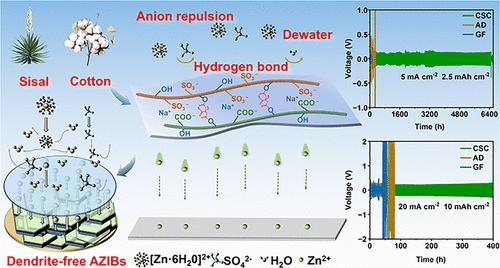Superior Stability Cellulose Composite Separators Enable High-Rate Zinc Ion Batteries with Ultralong Cycle Life
IF 9.1
1区 材料科学
Q1 CHEMISTRY, MULTIDISCIPLINARY
引用次数: 0
Abstract
Aqueous zinc ion batteries (AZIBs) are preferred for safety and cost-effectiveness but encounter challenges like zinc dendrite growth and side reactions, reducing their lifespan. Herein, a composite separator (CSC) for AZIBs is prepared using carboxylate sisal fiber (CSF) and sulfonation cotton fiber (SCF), followed by cross-linking with citric acid (CA). The exceptional stability of CSC─including high mechanical strength, wide pH tolerance, and suppression of hydrogen evolution─combined with high zinc ion migration number (tZn2+ = 0.70), leads to its remarkable electrochemical performance. The cycle life of Zn//Zn batteries with CSC is over 6400 and 400 h at 5 mA cm–2 and 20 mA cm–2, respectively. A Zn//MnO2 full battery exhibits 92.85% capacity retention after 10000 cycles at 5 A g–1 (∼16C), significantly outperforming the widely used commercial separators in AZIBs like glass fiber (GF). This work presents a highly effective but simple separator design strategy to achieve long-cycling, high-rate AZIBs.

优异的稳定性纤维素复合隔膜使高倍率锌离子电池具有超长的循环寿命
水性锌离子电池(azib)在安全性和成本效益方面是首选,但遇到锌枝晶生长和副反应等挑战,降低了其使用寿命。本文以羧酸剑麻纤维(CSF)和磺化棉纤维(SCF)为原料,与柠檬酸(CA)交联,制备了azib复合分离器(CSC)。CSC优异的稳定性,包括高机械强度、宽pH耐受性和抑制析氢,加上高锌离子迁移数(tZn2+ = 0.70),使其具有卓越的电化学性能。在5 mA cm-2和20 mA cm-2条件下,含CSC的Zn//Zn电池的循环寿命分别超过6400和400 h。在5 A g-1(~ 16℃)下,在10000次循环后,Zn//MnO2电池的容量保持率为92.85%,显著优于在azib(如玻璃纤维)中广泛使用的商业隔膜。这项工作提出了一种高效而简单的分离器设计策略,可以实现长周期、高速率的azib。
本文章由计算机程序翻译,如有差异,请以英文原文为准。
求助全文
约1分钟内获得全文
求助全文
来源期刊

Nano Letters
工程技术-材料科学:综合
CiteScore
16.80
自引率
2.80%
发文量
1182
审稿时长
1.4 months
期刊介绍:
Nano Letters serves as a dynamic platform for promptly disseminating original results in fundamental, applied, and emerging research across all facets of nanoscience and nanotechnology. A pivotal criterion for inclusion within Nano Letters is the convergence of at least two different areas or disciplines, ensuring a rich interdisciplinary scope. The journal is dedicated to fostering exploration in diverse areas, including:
- Experimental and theoretical findings on physical, chemical, and biological phenomena at the nanoscale
- Synthesis, characterization, and processing of organic, inorganic, polymer, and hybrid nanomaterials through physical, chemical, and biological methodologies
- Modeling and simulation of synthetic, assembly, and interaction processes
- Realization of integrated nanostructures and nano-engineered devices exhibiting advanced performance
- Applications of nanoscale materials in living and environmental systems
Nano Letters is committed to advancing and showcasing groundbreaking research that intersects various domains, fostering innovation and collaboration in the ever-evolving field of nanoscience and nanotechnology.
 求助内容:
求助内容: 应助结果提醒方式:
应助结果提醒方式:


